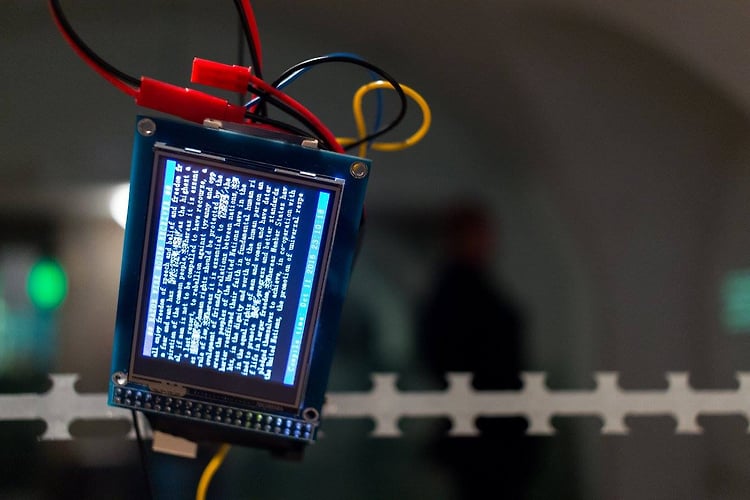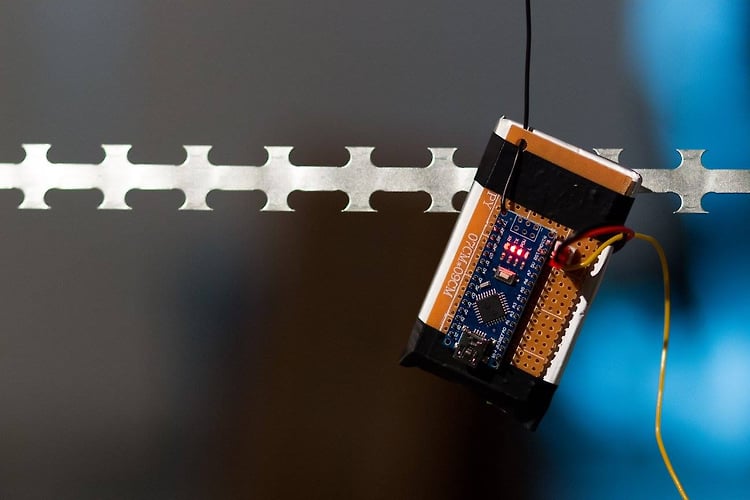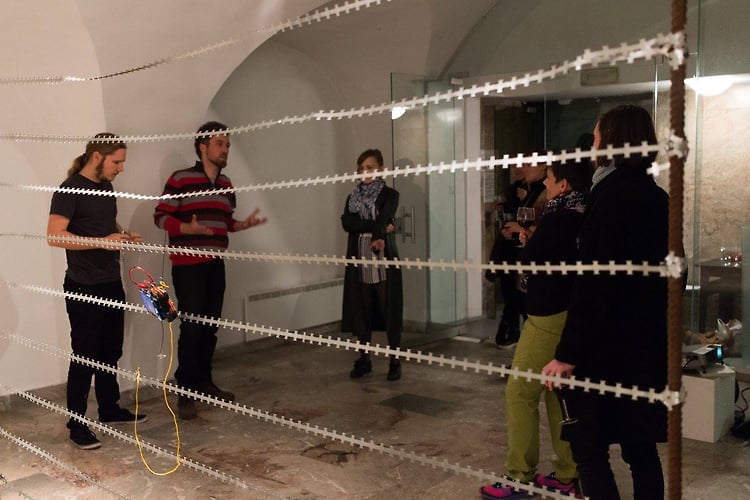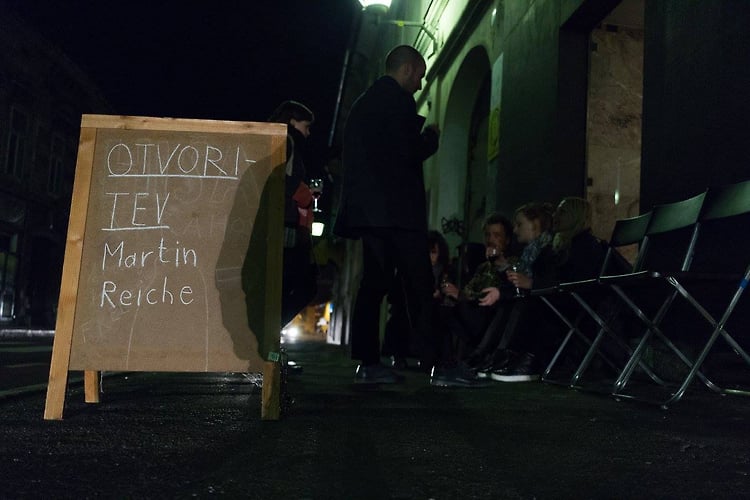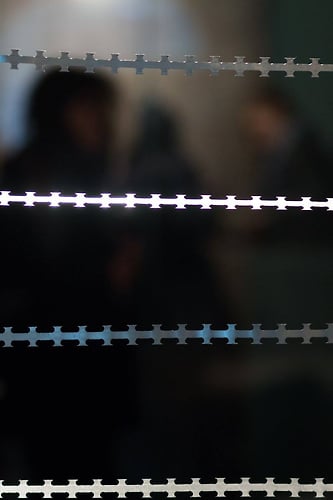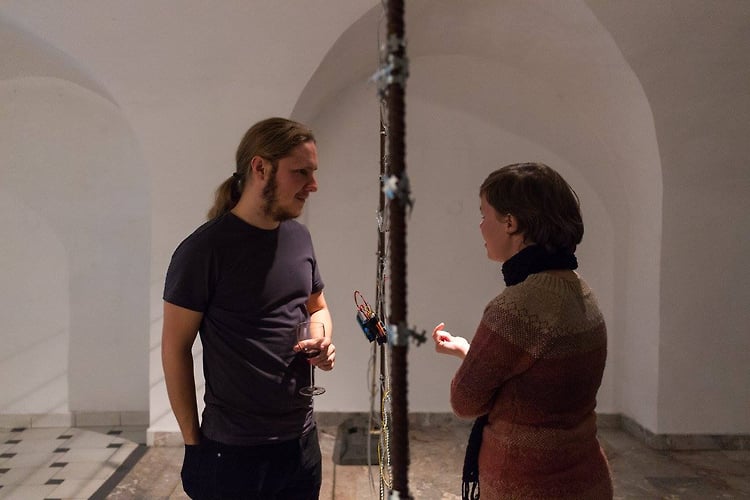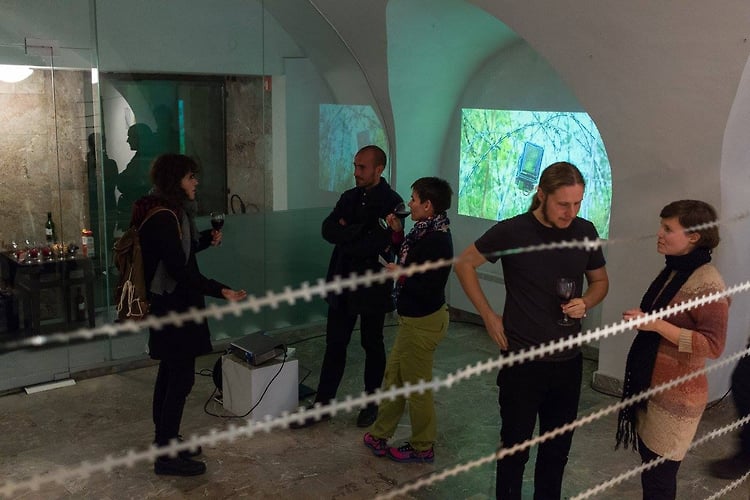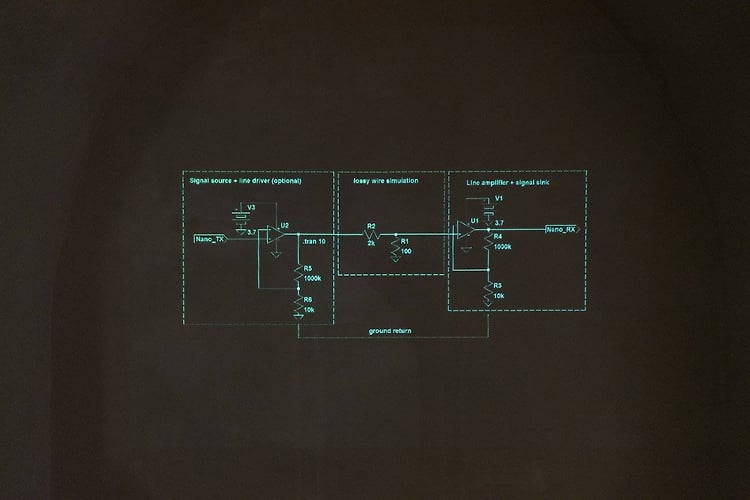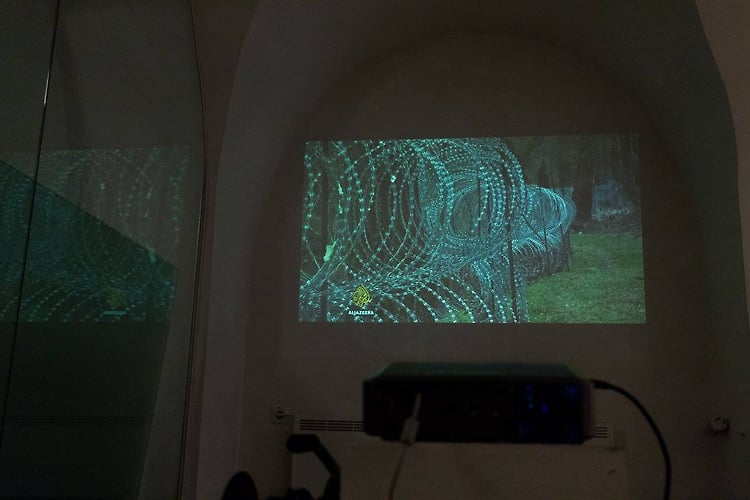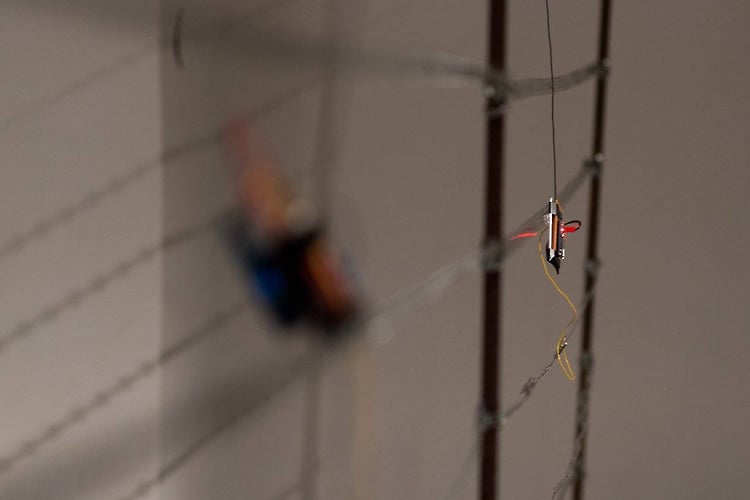MARTIN REICHE 2016
Martin Reiche
Razor-wire modem
Written by: Kaja Kraner
The work of Martin Reiche can be, on the basis of the chosen medium, placed in the intersection of contemporary art and technology or science. His research constant is the effect of technological development on the relation between humans and technology and, at the same time, ways in which technology and technological development influence interpersonal relations. In this sense, the artist, to a degree, draws close to political activism, which, for example, tries to subvert existing technological infrastructure meant to maintain control, security and regulation of the populace from positions of power into tools of “bottom-up” emancipation.
In the frame of the residential stay, Reiche focused on one of the most current regulation technologies on the so-called “technical obstacles”, which are supposed to help regulate or even stop the migration waves coming from war-torn or otherwise devastated areas into the EU and thus protect its citizens. In the project Razor-wire modem, the artist developed a prototype of a modem and receiver, which could transform the existing “technical obstacles” into an open communication network. Thus he tries to change the means of separation into tools for (increasing) the basic won universal citizen and civil rights, which are lately ever more and dangerously (again) becoming a privilege of those, who were lucky enough to be born in the “right corner of the Earth”, or just those, who have enough economic and political power.
The exhibition setup, in which he shows the prototype, was composed of a modem prototype sending signals through a technical obstacle and an accompanying receiver, which translated the signals into established language codes and displayed them on a screen. The choice of the sent and the decoded message wasn’t accidental, the message was an excerpt from the 1948 UN Universal Declaration of Human Rights, which, among defining basic human rights, also states the right of everyone “to seek and to enjoy in other countries asylum from persecution”. In addition, he also presented a documentary video work, also made during the residency in which he tried to contextualize his intervention. Among other things also by giving the opportunity to express their opinions about these “technical obstacles” to those, whose everyday lives were affected by their instalment under the pretence of protection.
The correspondence between Martin Reiche and an anonymous engineer whom the GuestRoomMaribor team asked for an opinion about the technical aspects of the proposed project.
First e-mail from Martin Reiche:
»„Barbed Wire Open Communication Network“ Critical technology, art & resistance research project Martin Reiche, 2016
This artistic research project will investigate the potential of (barbed wire or other metal) fences to be used as an open network infrastructure. Barbed wire, as one of the most pervasive protection and oppression structures used world-wide, is made out of metal and has high conductivity, therefore can be used as a medium to transfer data as packages of electronic current. Building networks on the basis of already existing barbed wire fences in cities or on the countryside can be a way to subvert the purpose of the wire as a means of protection towards becoming an infrastructure for liberal information exchange, and therefore a democratic medium. The project aims at creating an open prototype for a device (based on open hardware such as arduino[1]) that can be plugged to a barbed wire fence and serve there as a modem (when also connected to a laptop), converting the fence into an open communications network, similar to a Local Area Network (LAN). The open prototype is to be put in the public domain both hardware- and software-wise, and the results of the research, as well as of real-world applications will be shared with the public both onsite and on the internet through open specifications (hardware, software, protocols), local workshops and (if possible under law) video and print publications. The goal is to concentrate all necessary resources that would allow the general public to be able to create instant low-cost wired (and possibly encrypted) covert communication networks on already existing infrastructure, which could be used covertly in countries with internet access restrictions, as a local darknet[2], or as a paramilitary infrastructure behind enemy lines.«
Answer of the anonimous engineer:
»My dearest Martin Reiche.
Since using a fence as an antenna you won't be able to work with short enough wavelenghts to reach frequencies of 2.4Ghz or more to work with common wireless protocols, meaning no possibilities of connecting to the fence using everyday devices people commonly own these days. In time of crysis, do you think people would go and build a bunch of special devices you would propose just to access your network instead of using already existing devices? If so, why?
In what frequency band do you expect to work? What would be the highest frequency you think you could reach? What if the frequency would be so low because of fence's big size being able to work with only very large wavelengths, that it could carry only a few bytes per minute? Would you regard such a medium as usable?
You say one could use the fence as a modem when connected to the laptop. Are you sure you're going to get such high transmission speeds out of the fence? And, why use the fence at all, when you already have a nice working wifi on the laptop?
Do you think coding together a whole stack of protocols that actually work is managable for one person given limited time? What challenges do you expect at the lowest level of the protocol stack, regarding filtering the noise out, trying to make data transmision error-proof? What about the levels above that, packet acknowledgment, retransmission etc.? Do you intend to work with some of already existing protocol implementations? if so, which ones?
Would the fence be of any use if it would have only a few meters of reachable signal? If you want a decent (usable) signal strength, you would need to work out a stronger power supply. What are your thoughts on that? What kind of power supply did you intend to work with?
Do any of your other project presented online actually do anything or is the main purpose aesthetics?
Is there a possibility of the project ending up as more of a pretty sculpture, an eye candy but useless, giving people only sentimentality, instead of actually giving them power in times of crysis? Could another emperor end up naked? Don't we already live in the midst of the greatest orgy of naked emperors in the history of human kind? Here in the city of Maribor, we have a tradition we're most proud of, a tradition of hanging or at least castrating people who speak empty words, people who promise but don't deliver. But you seem to be a sincere young gentelman, a man of word, a man of substance one can feel. Have no fear. Maribor welcomes you.«
Answer of Martin Reiche:
»Oh dearest unknown fellow citizen,
May I have the honour and pleasure to answer your surprisingly humorous questions, which to ask a German citizen, as is well known around this continent not to have any sense for humour whatsoever, is quite an extraordinary endeavour. By any means, I will gladly sketch an answer to your questions. As you are familiar with historical references, I will also follow your lead here and quote a US patent of 1933 as the basis of my argument: https://www.google.de/patents/US2001095?dq=party+line&hl=de&sa=X&ved=0ahUKEwiQ39Pb75fMAh... As you are an engineer, you are familiar with signal processing through conducting materials, which is basically what the project in question is all about. Interestingly, using barbed wire fences as telephone systems was quite a common thing in the US countryside for decades, as states for example this hilarious article (http://gizmodo.com/barbed-wire-fences-were-an-early-diy-telephone-network-1493157700). Based on this background, re-appropriating barbed wire which is now used in other circumstances, not to fence kettle, but to fence Europeans from the one side and immigrants from the other seems like a logical, if not necessary, but in anyway poetic conclusion. Technically, there definitely will be more problems arising, but it would not be called an art project if it was easy. You will kindly understand that. Following your argument, the protocols I will of course not do by myself, for the same reason that I do not like to stab a knife into my hand: it just hurts too much. The good thing is, that protocols like X.25 have existed for a long time, are well-documented and also fairly well-implemented. Transmission speed through the fence will most probably be horrible - but that is not what this project is about. I am not interested in creating a replacement for anything. I want to show that technology used for exclusion can very well be re-appropriated for inclusion. You just have to find the maniac researcher-artist-engineer to try it. That seems to be me in this case.
Martin Reiche:
Simon Žlahtič
Leta 2015 se je Slovenija odločila za postavitev t. i. tehnične ovire, ki naj bi preprečila nekontroliran prehod meje ob t. i. begunskem valu prebežnikov. Ograja sestavljena iz kolutov bodeče žice tako predstavlja ne le fizične, temveč tudi mentalno pregrado. Njena postavitev se utemeljuje s skrbjo za prebivalce ob meji, čeprav je slika na terenu popolnoma drugačna. Obmejni prebivalci ograje večinoma ne želijo in se jim zdi nepotrebna, saj morajo z njo živeti. Njihove izkušnje z žico negirajo njeno vlogo, saj naj bi ta prebivalce varovala in ne ogrožala, kot se to dogaja. Mediji poročajo o poškodovanih otrocih in poginulih živalih, ki se zapletejo v žico. Odrezala je kmete od zemlje in regije ob meji od pomembnega vira zaslužka, saj se turistična dejavnost na takih območjih, ki zaradi žice spominjajo na vojna, stežka razvija. Za nameček moramo še omeniti, da beguncev na omenjenih območjih sploh ni.
Vsa ta dejstva nekako povzame prvi del dokumentarističnega videa berlinskega umetnika Martina Reichea na razstavi. Jedro njegovega zanimanje je polje komunikacije in njenih preprek. Vrsto let se že ukvarja z različnimi projekti in raziskovanjem na to temo. Pri tem izhaja iz lastnosti prevodnosti kovinske žice in ideje ameriških rančarjev, ki so bodečo žico na svojih posestvih uporabljali kot vzporedno infrastrukturo komunikacije. V obdobju uporabe telegrafa, kasneje tudi telefona, so ogromna neposeljena območja ameriških prostranstev premagovali preko žičnatih ograd, ki so se stikale med posestvi in tako tvorile stotine kilometrov omrežja.Detajl intervencije na državni meji.Tekom rezidence je Reiche razvil "Razor Wire Modem" in sprejemnik, ki sta prilagojena delovanju na bodeči žici. Namen modema je pošiljanje signalov skozi žico, ki obteka mejo, vloga sprejemnika pa, da sprejete signale dešifrira in pretvori v človeku berljive znake in vsebine ter jih prikaže na zaslonu. Načrte za izgradnjo podobnih naprav bo namenil prosti uporabi, saj podpira idejo odprte uporabe tehnologije, ki jo vidi kot pomembno orodje za premagovanje tako fizičnih, kot tudi mentalnih ovir. Kot nam kaže drugi del videa, je Reiche svoj modem tudi inštaliral v naravno okolje bodeče žice in poslal signale skozi žico, s tem pa simbolno spremenil ograjo iz sredstva izključevanja in delitve v sredstvo povezovanja in komunikacije. Pomenljivo je tudi dejstvo, da je za vsebino prenosa podatkov uporabil listino Združenih narodov iz leta 1948, ki govori o temeljnih človekovih pravicah, še posebej je bistven 14. člen, v katerem beremo, da ima vsakdo pravico v drugih državah iskati in uživati pribežališče pred preganjanjem. S tem je na simbolni način izničil ogrado tudi s vsebino, ne zgolj tehnično preobrazbo.
Za potrebe galerijske razstave je Reiche posnel in sestavil prej omenjen video, ki kontekstualizira delo in dokumentira njegovo performativno dejanje na terenu samem. Kot nekakšne relikvije, ki ponazarjajo ogrado, je priskrbel še najdene predmete, ki po principu ''pars pro toto'' govorijo o resničnosti ograje, ki je našim očem skrita. Dokumentaristični značaj jim daje forma v kateri so predstavljeni – vrečka, ki spominjajo na dokazno vsebino. K predstavi o žičnati ograji zato pomembno prispeva tudi rekonstrukcija žičnate ograje v galerijskem prostoru. S tem je poustvaril fizično prepreko, ki jo z delovanje modema in pretokom informacij ponovno želi premostiti in preseči.
Rezalno Žičnati Modem
Simon Žlahtič
Leta 2015 se je Slovenija odločila za postavitev t. i. tehnične ovire, ki naj bi preprečila nekontroliran prehod meje ob t. i. begunskem valu prebežnikov. Ograja sestavljena iz kolutov bodeče žice tako predstavlja ne le fizične, temveč tudi mentalno pregrado. Njena postavitev se utemeljuje s skrbjo za prebivalce ob meji, čeprav je slika na terenu popolnoma drugačna. Obmejni prebivalci ograje večinoma ne želijo in se jim zdi nepotrebna, saj morajo z njo živeti. Njihove izkušnje z žico negirajo njeno vlogo, saj naj bi ta prebivalce varovala in ne ogrožala, kot se to dogaja. Mediji poročajo o poškodovanih otrocih in poginulih živalih, ki se zapletejo v žico. Odrezala je kmete od zemlje in regije ob meji od pomembnega vira zaslužka, saj se turistična dejavnost na takih območjih, ki zaradi žice spominjajo na vojna, stežka razvija. Za nameček moramo še omeniti, da beguncev na omenjenih območjih sploh ni.
Vsa ta dejstva nekako povzame prvi del dokumentarističnega videa berlinskega umetnika Martina Reichea na razstavi. Jedro njegovega zanimanje je polje komunikacije in njenih preprek. Vrsto let se že ukvarja z različnimi projekti in raziskovanjem na to temo. Pri tem izhaja iz lastnosti prevodnosti kovinske žice in ideje ameriških rančarjev, ki so bodečo žico na svojih posestvih uporabljali kot vzporedno infrastrukturo komunikacije. V obdobju uporabe telegrafa, kasneje tudi telefona, so ogromna neposeljena območja ameriških prostranstev premagovali preko žičnatih ograd, ki so se stikale med posestvi in tako tvorile stotine kilometrov omrežja.Detajl intervencije na državni meji.Tekom rezidence je Reiche razvil "Razor Wire Modem" in sprejemnik, ki sta prilagojena delovanju na bodeči žici. Namen modema je pošiljanje signalov skozi žico, ki obteka mejo, vloga sprejemnika pa, da sprejete signale dešifrira in pretvori v človeku berljive znake in vsebine ter jih prikaže na zaslonu. Načrte za izgradnjo podobnih naprav bo namenil prosti uporabi, saj podpira idejo odprte uporabe tehnologije, ki jo vidi kot pomembno orodje za premagovanje tako fizičnih, kot tudi mentalnih ovir. Kot nam kaže drugi del videa, je Reiche svoj modem tudi inštaliral v naravno okolje bodeče žice in poslal signale skozi žico, s tem pa simbolno spremenil ograjo iz sredstva izključevanja in delitve v sredstvo povezovanja in komunikacije. Pomenljivo je tudi dejstvo, da je za vsebino prenosa podatkov uporabil listino Združenih narodov iz leta 1948, ki govori o temeljnih človekovih pravicah, še posebej je bistven 14. člen, v katerem beremo, da ima vsakdo pravico v drugih državah iskati in uživati pribežališče pred preganjanjem. S tem je na simbolni način izničil ogrado tudi s vsebino, ne zgolj tehnično preobrazbo.
Za potrebe galerijske razstave je Reiche posnel in sestavil prej omenjen video, ki kontekstualizira delo in dokumentira njegovo performativno dejanje na terenu samem. Kot nekakšne relikvije, ki ponazarjajo ogrado, je priskrbel še najdene predmete, ki po principu ''pars pro toto'' govorijo o resničnosti ograje, ki je našim očem skrita. Dokumentaristični značaj jim daje forma v kateri so predstavljeni – vrečka, ki spominjajo na dokazno vsebino. K predstavi o žičnati ograji zato pomembno prispeva tudi rekonstrukcija žičnate ograje v galerijskem prostoru. S tem je poustvaril fizično prepreko, ki jo z delovanje modema in pretokom informacij ponovno želi premostiti in preseči.


